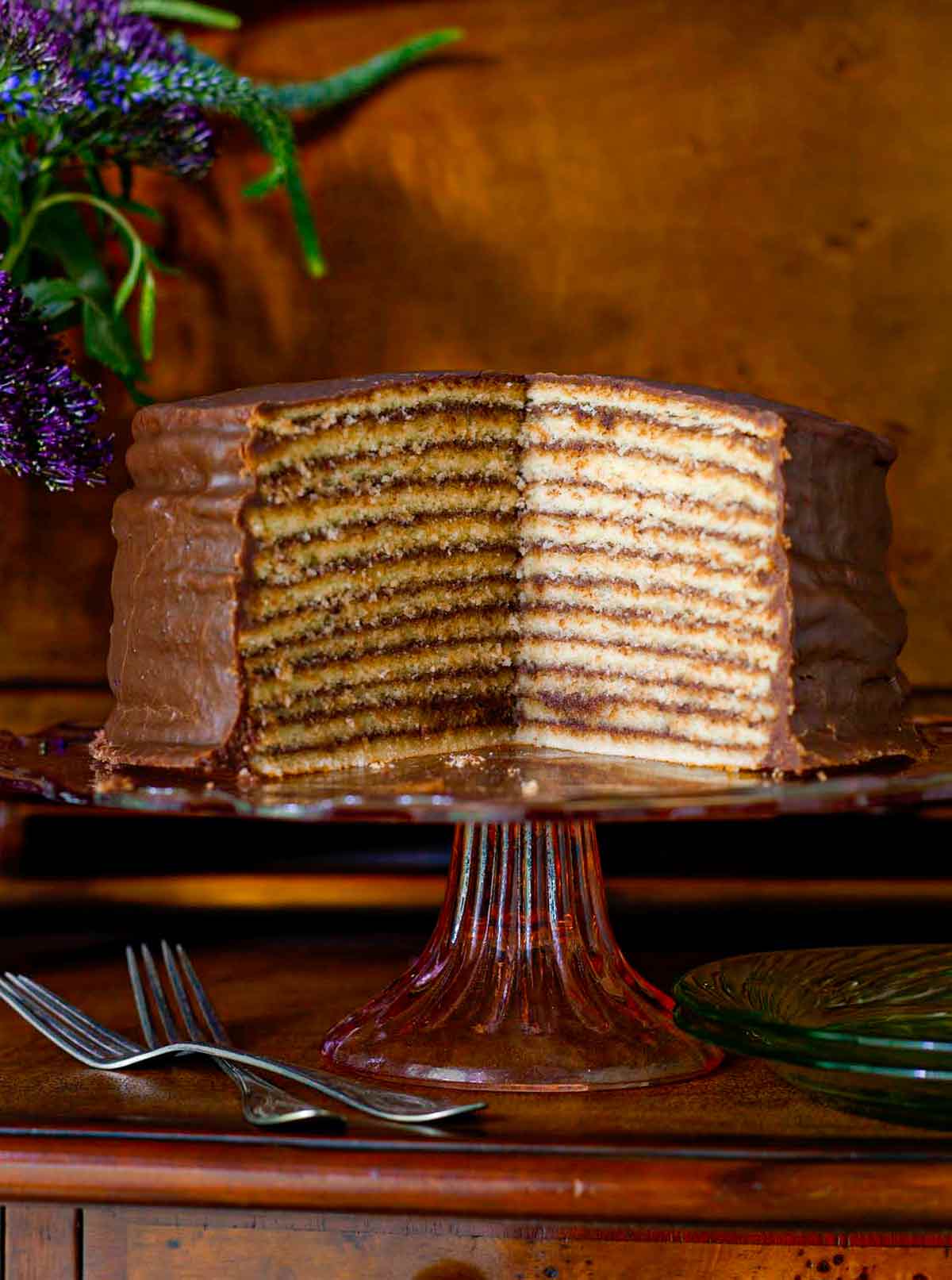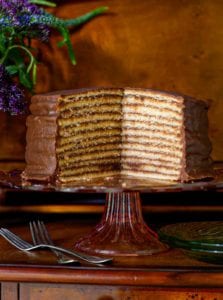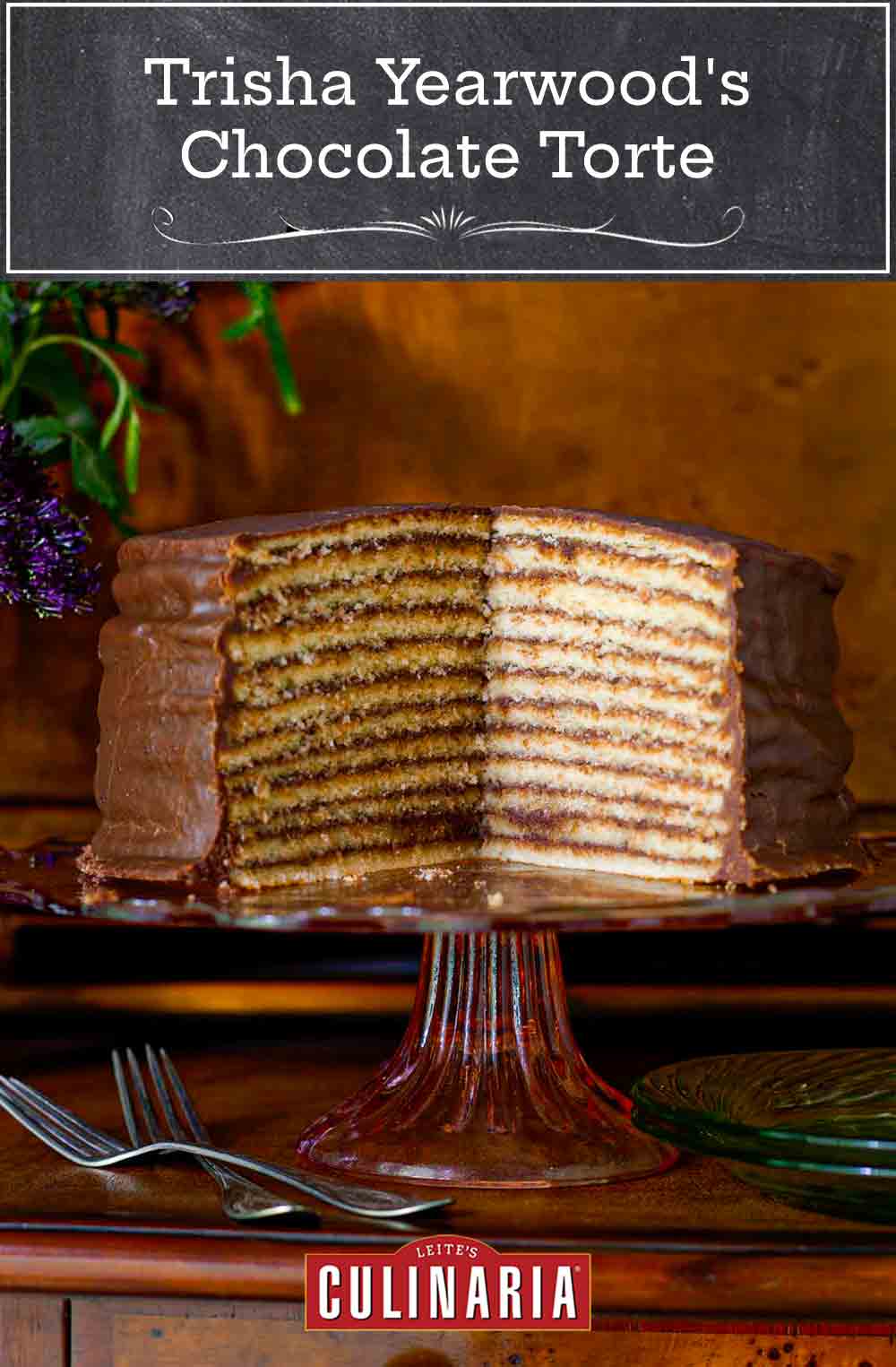
As author Trisha Yearwood says of this cake, you may take a look at the layers and think, “There is no way I’m making this at home!” “But,” she continues to explain, “the recipe is both simple and savvy, baking several skinny cakes in 9-inch cake pans. It sure beats making a plain ole double layer chocolate cake and slicing both of those suckers into six with that inevitable and maddening mess of crumbs that comes from hacking away at the cake with a bread knife.” Impressive in stature as well as taste.–Trisha Yearwood
HOW TO MAKE THIS TORTE A SIMPLE TWO-LAYER CAKE
Yes, we understand, you don’t always have the time or patience for tradition–or lots and lots of layers. So sure, why not, go ahead, bake the batter in two standard 9-inch round cake pans and then stack and frost the two layers as is, as you would any layer cake. Then call it a day–a darn good day.

Trisha Yearwood’s Chocolate Torte
Ingredients
For the chocolate glaze
- 1 1/2 sticks (6 oz) butter
- 5 ounces unsweetened chocolate
- 4 1/2 cups granulated sugar
- 2 1/4 cups evaporated milk
- 2 teaspoons vanilla extract
- 1 tablespoon instant coffee granules, preferably French roast
For the cake
- 2 sticks (8 oz) butter, at room temperature, plus more for the pans
- 2 1/2 cups granulated sugar
- 6 large eggs, at room temperature
- 1 teaspoon vanilla extract
- 2 cups plus 1 tablespoon milk
- 4 cups self-rising flour, plus more for the pans
Instructions
Make the glaze
- [Editor’s Note: Be sure to make the glaze before you bake the cakes.] In a large saucepan over medium-low heat, melt the butter. Add the chocolate and stir until melted.
- Add the sugar and stir until it dissolves. Then stir in the evaporated milk, vanilla, and the instant coffee, increase the heat to medium-high, and bring it to a boil.
- Continue cooking, stirring constantly, until the mixture thickens to a glaze, about 20 minutes.
- Remove the glaze from the heat.
Make the cake
- Preheat the oven to 350°F (176°C). Butter and flour at least four 9-inch cake pans.
- In the bowl of a stand mixer or in a large bowl with an electric mixer, beat the butter and sugar until smooth. Add the eggs, 1 at a time, beating just until blended after each addition.
- In a small bowl, mix the vanilla with the milk. Add the flour to the egg mixture alternately with the milk mixture, beginning and ending with the flour.
- Pour a very thin layer of batter—about 7 tablespoons—into each pan, shaking the pans to distribute the batter to the edges. Bake the layers for 11 to 13 minutes.
- While the first cake layers bake, return the glaze to low heat as the glaze must be warm to spread on the cake layers.
- When the cake layers are done, immediately remove the layers from the pans and, working one at a time, place the layers on a cake stand and immediately slather with some of the warm glaze.
- Bake all of the remaining batter in this manner and continue to stack and glaze in this fashion. You should be able to get 12 layers from this recipe. Reserve the last of the glaze to dribble over the top of the cake.

Nutrition
Nutrition information is automatically calculated, so should only be used as an approximation.
Recipe Testers’ Reviews
An impressive cake. The thin layers of both cake and icing were visually appealing as well as delicious. The icing has a taste similar to brigadeiros, or Brazilian chocolate fudge balls, with an almost caramel-like quality to the chocolate and coffee flavor.
The recipe calls for an interesting technique of layering the cake while still hot, and it worked. It’s labor-intensive, but the extra time in baking thin layers of batter is definitely offset by not having to cut standard-size cakes into layers and deal with all the crumbs while spreading the icing and assembling them.
I halved the recipe and got 8 layers from it, although I needed more than the amount of icing specified to effectively cover each layer. I also made the cake gluten-free, and the recipe adapted perfectly. The finished cake is not really rich, but is very sweet. I might be inclined to reduce the sugar next time I make this, but it’s otherwise a wonderful dessert.
I must admit that when I first read the recipe, I was a bit overwhelmed, but I was quite surprised at how easy this cake is to make and how beautiful and tasteful it is.
I follow a gluten-free diet, so I had to switch the self-rising flour for the exact same amount of all-purpose GF flour ( Bob’s Red Mill) and did what the site Art of Gluten-Free Baking says with regard to adding the baking powder and salt. Worked beautifully. I was able to divide the batter into 3 pans and divided each cake into 2 layers, so I had 6 layers altogether. I’m sure I could have cut each into 3 layers, but I was too scared of breaking them. We had friends over for dinner and this was an absolutely HUGE success.












My glaze came out really sticky. Did anyone else have this problem? What did I do wrong?
Hi Sara, I’m reaching out to our testers to see if they had a similar question. Just curious, what was your weather like when you made the cake? Sometimes humidity will affect the consistency.
Beth, The weather can effect the out come of your cake. If it’s raining or the humidity is high there are some things I will not bake. Example 7 minute icing. I did make a 7 layer cake with high humidity and it took the icing longer to set. I ended up putting the cake in my icebox.
Thanks for your comment, Charlotte. I’m sure it’s helpful to some of our readers!
“The most well-known of the typical tortes include the Austrian Sachertorte and Linzertorte, the German Schwarzwälder Kirschtorte and the many-layered Hungarian Dobos torte. But other well-known European confections are also tortes, such as the French Gâteau St. Honoré. Tortes are commonly baked in a Springform pan.” From wikipedia.
Traditional Southern, as in the US? I don’t think so! Torte is European, not your American tradition, ours!
Yes, Nina, you are correct. A torte is originally European. But those European traditions came to the South many years ago and were adopted into the cuisine. Although I will say that I see these most often referred to as a 12 layer cake, many times done as a caramel cake.
I was thinking the same thing. I also thought a torte was a flourless cake? I could be wrong though.
You’re very close, Jb. A torte typically uses little to no flour, and ground nuts in place. As Beth mentions, this is probably more accurately described as a 12 layer cake.
Do you know what’s even easier than this method and makes the layers even thinner? Spread about 1/4 cup on the BACK of the cake pans; I use Baker’s Joy to make sure they’ll come off easily. That’s the way I learned to make Dobostorte (my all-time favorite).
Ellen, many thanks for sharing your trick with us!